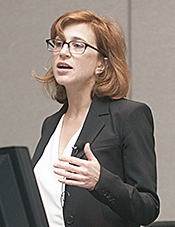
Stacie Deiner, M.D., M.S.: ‘One of the things we anesthesiologists might not do as well as we should is give a drug and wait for it to work. There is a benefit in that for the elderly.’
There is a “silver tsunami” of growing evidence that anesthesia could pose a greater risk of cognitive side effects for the elderly when compared to younger patients, but steps can be taken to proactively identify those patients at risk for postoperative cognitive dysfunction (POCD).
Those steps were discussed Tuesday in “Mastering Anesthesia for the Elderly Patient,” presented by Stacie Deiner, M.D., M.S., Associate Professor of Anesthesiology, Geriatrics and Palliative Medicine, and Neurosurgery at Mount Sinai Hospital.
“The anesthesia-related mortality for a 70-year-old patient is approximately double the rate for a 50-year-old patient,” Dr. Deiner said. “Is age alone the issue? Being old is not the only issue. How do we, in an objective way, talk about identifying those who need extra services and those who are O.K.?”
The first step needs to be a preoperative assessment because geriatric consultations have been shown to be effective, she said. This starts with a simple assessment checklist developed by the American College of Surgeons and the American Geriatrics Society. Important items to address include monitoring for multiple prescriptions and determining a baseline frailty score.
Frailty increases risk and is a predictor of hospitalization, need for nursing home care, surgical complications and death. It is a state of decreased homeostatic reserve, and is defined by physiology and function, Dr. Deiner said.
“Frailty is a combination of genetic and environmental factors, and it occurs when decline occurs at the same time across multiple organ systems,” she said. “It is a result of inflammatory and oxidative stress.”
Indications of frailty include weight loss, grip strength, exhaustion, low physical activity and walking speed. A five-question frail scale can be used to assess the state of a patient preoperatively and can even be done by telephone.
“Frailty is something that can be improved,” Dr. Deiner said. “People can transition in and out of frailty with interventions.” These can include exercise, hormone replacement and ACE inhibitors. The use of vitamin D is another option, but is controversial.
Intraoperative management also is important because of changes in total body water, lean mass, increased fat, hepatic metabolism and renal excretion as patients age. A practical consideration is to cut opioid doses by 50 percent due to receptor alteration. Neuromuscular blockage should be monitored because changes in renal and hepatic clearance are variable.
“You may want to consider divided doses,” Dr. Deiner said. “One of the things we anesthesiologists might not do as well as we should is give a drug and wait for it to work. There is a benefit in that for the elderly.”
Postoperatively, it is important to understand the difference between delirium and cognition. Delirium is a change in mental status and a disturbance in attention that is a clinical diagnosis, and it is different from POCD, she said.
In the area of pain control, there is much debate, but a good approach is to move older patients to use nonopioid pain medications, and even use them preoperatively, Dr. Deiner said.
Also important is to consider the use of regional anesthesia and the depth of anesthesia. Studies have shown that postoperative delirium was cut in half for patients not in deep sedation, she said, indicating that sedation added to a patient on regional anesthesia can lead to features similar to general anesthesia.
Dr. Deiner concluded her presentation by reviewing studies showing that even young and middle-age patients need time to recover from anesthesia, but that the elderly require a longer recovery time.
In light of the growing information about the effects of anesthesia on the elderly, next year’s annual meeting will add a geriatric anesthesia track, Dr. Deiner said, and she encouraged session attendees to suggest topics of discussion to meeting organizers.
Return to Archive Index
